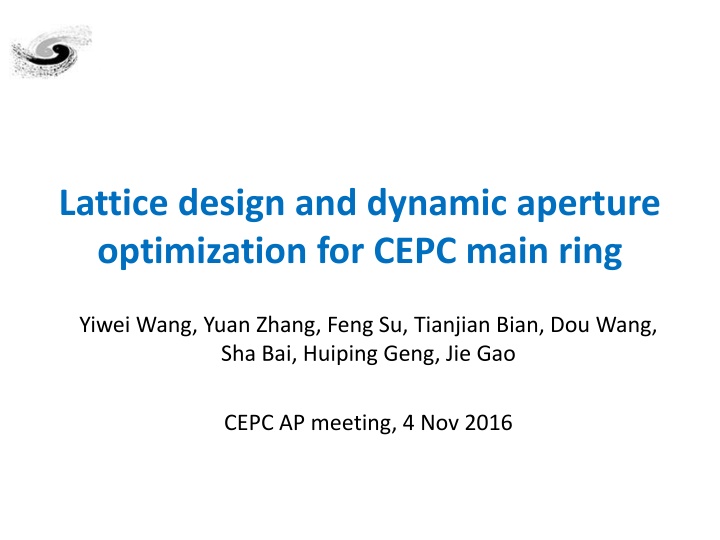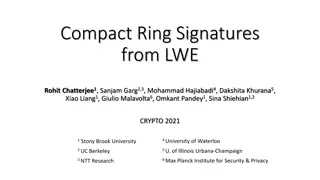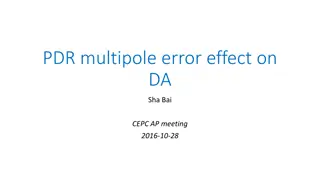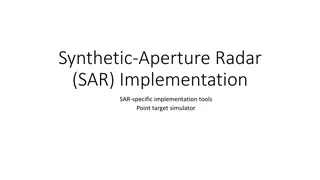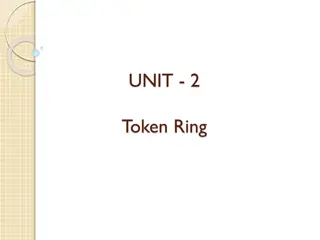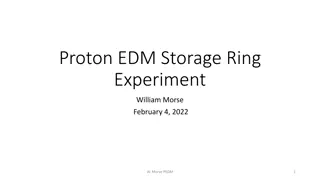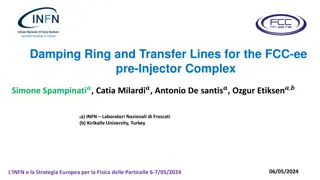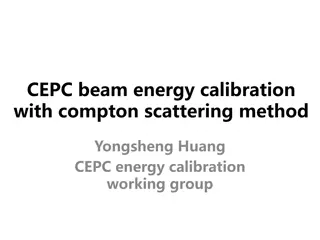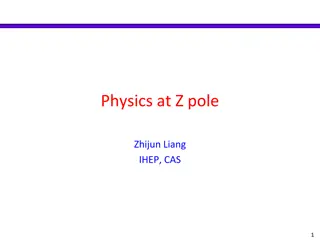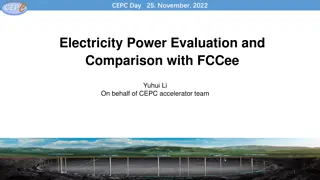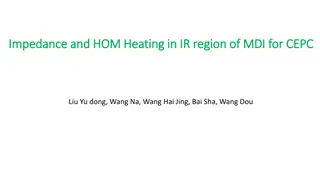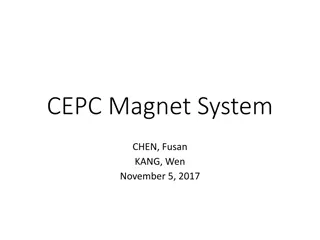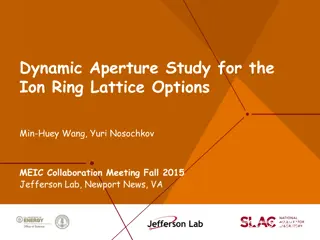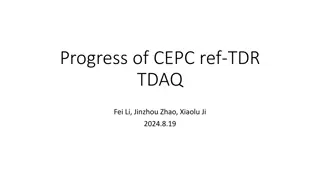Dynamic Aperture Optimization for CEPC Main Ring
Lattice design and dynamic aperture optimization for the Circular Electron Positron Collider (CEPC) main ring were discussed, focusing on maximizing the dynamic aperture through lattice configurations in the ARC region, interaction region, and partial double ring region. Various strategies such as chromaticity corrections, sextupole schemes, and dispersion optimization were highlighted for achieving the desired design parameters and luminosity. The study also addressed the challenges of correcting tune shifts and managing high-order dispersion effects to enhance machine performance.
Download Presentation

Please find below an Image/Link to download the presentation.
The content on the website is provided AS IS for your information and personal use only. It may not be sold, licensed, or shared on other websites without obtaining consent from the author.If you encounter any issues during the download, it is possible that the publisher has removed the file from their server.
You are allowed to download the files provided on this website for personal or commercial use, subject to the condition that they are used lawfully. All files are the property of their respective owners.
The content on the website is provided AS IS for your information and personal use only. It may not be sold, licensed, or shared on other websites without obtaining consent from the author.
E N D
Presentation Transcript
Lattice design and dynamic aperture optimization for CEPC main ring Yiwei Wang, Yuan Zhang, Feng Su, Tianjian Bian, Dou Wang, Sha Bai, Huiping Geng, Jie Gao CEPC AP meeting, 4 Nov 2016
Outline Lattice of arc region, interaction region and partial double ring region Target of dynamic aperture for main ring Optimization of dynamic aperture Further optimization of dynamic aperture Increase dispersion and beta* Crab sextupole Sawtooth effect
Lattice of ARC Region FODO cell, 90 /90 , non-interleaved sextupole scheme period N=5cells all 3rd and 4th resonance driving terms (RDT) due to sextupoles cancelled, except small 4Qx, 2Qx+2Qy, 4Qy, 2Qx-2Qy tune shift dQ(Jx, Jy) is very small DA on momentum: large Chromaticity dQ( ) need to be corrected with many families DA off momentum: with many families to correct dQ( ) and I break down - -I I - -I I Sextupole configuration
Lattice of Interaction Region Local chromaticity correction with sextupoles pairs separated by I transportation all 3rd and 4th RDT due to sextupoles almost cancelled up to 3rd order chromaticity corrected with main sextupoles, phase tuning and additional sextupoles tune shift dQ(Jx, Jy) due to finite length of main sextupoles corrected with additional weak sextupoles Break down of I, high order dispersion could be optimized with odd dispersion scheme or Brinkmann sextupoles MT CCX CCY FT IP L*= 1.5m x*= 0.22mm y*= 1mm GQD0= -200T/m GQF1= 200T/m LQD0=1.69m LQF1=0.90m - -I I - -I I
Lattice of Partial Double Ring Region Feng Su, Yiwei Wang Yiwei Wang CEPC-SppC Study Group Meeting 5
Lattice of the Whole Ring A lattice of the whole ring (ARC+PDR+IR) basically fulfilling the design parameters
Target of dynamic aperture for main ring Parameter Symbol Unit Value Status 1034cm-2s-1 Luminosity per IP Lmax 2.01 - x/ y Beta functions at IP m 0.275 /0.0013 0.22 /0.001 x/ y nm rad Main ring emittance 2.05 /0.0062 2.15/0.0065 x/ y nm rad Injection emittance 3.5 / 0.17 3.5/0.17 nm rad Transversacceptance* Ax/Ay 787 / 4.17 Energy acceptance AE % 2.0 1.9 16 / 45 (dp/p=0) 3 / 5 (dp/p= 2%) (no errors, mean value for two poles of axis) DA requirement from beam-beam (inclu. errors and beam-beam effect) 20 / 40 (dp/p=0) 5 / 10 (dp/p= 2%) DAx/DAy DA requirement from injection (inclu. errors and beam-beam effect) 20 / 26 (dp/p=0 and dp/p= 0.5%) DAx/DAy - Based on the parameters wangdou20160918 H-low power . *assuming coupling factor =5% for injection beam, x,r=200 m, x,i=60 m, ws = 4 mm, nr = 5, ns = 5
Optimization of dynamic aperture Dynamic aperture study Bare lattice Synchrotron motion included w/o and w/ damping Tracking with around 1 times of damping time Coupling factor =0.003 for y Working point (0.08, 0.22) Downhill Simplex algorithm applied Further optimization is possible Larger dispersion for IR sextupoles y*= 1mm -> 1.3mm (new parameters) More families in IR Study of effects such as quantum excitation, solenoid field, errors and misalignments are under going
Increase dispersion and beta* Dispersion increased to be 3 times of former one Beta* increased from (0.22m, 1mm) to (0.275m, 1.3mm) which is used in the latest parameter list H low power, wangdou20160929 FFSR_1 FFSR_1_2
Add crab section Lattice design requirement Strength* *Ref: Yuan Zhang, CW , 2008 Phase to IP: 2m /2, (2n+1) /2 for x,y plane Beta function should be easily adjusted Chromaticity contribution especially which is not on phase should be small
New IR lattice Lattice of FFS with with increased dispersion, beta* and crab sextupole is ready Re-optimization of the aberrations of FFS need to be done Finite length effect of crab sextupole need to be studied Dynamic aperture for the ring including this new IR lattice is undergoing.
Sawtooth (cont.) The change of orbit due to energy loss can be corrected in PDR region by tapering the strength of magnets. This effect in ARC region can be eased with more RF stations Maximum of energy deviation Maximum of sawtooth orbit Beam size With present parameters and lattice design: Maximum of energy deviation ??is much smaller than FCC-ee mainly due to more RF stations (8/2) and lower energy (120GeV/175GeV). For single ring, PDR, APDR schemes: Their relative sawtooth orbits are all less than one sigma of beam size thus should not significantly affect the DA. The sawtooth effect of the three schemes don t make obvious difference.
Reference Yuan Zhang, CW , 25 Aug 2008
Summary A lattice of the whole ring (ARC+PDR+IR) fulfilling the design parameters is ready. Dynamic aperture study is made step by step ARC/ ARC+PDR/ ARC+PDR+IR Further optimization of dynamic aperture with increased dispersion, beta* and crab sextupole is undergoing.
